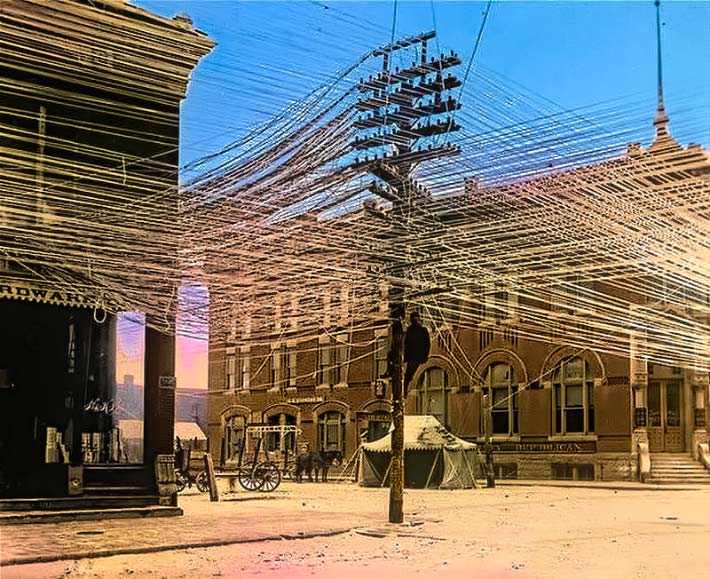
A COMMUNICATION WORKER SAFETY ZONE didn’t exist between telecom and power lines in 1911, as shown in this photo of a lineman in downtown Pratt, Kansas. There is one required today on poles, but Duke Energy says in its legal brief that it would not exist on its poles but for the presence of AT&T and other communications attachments. They want AT&T to pay their fair share of that zone.
Duke Energy is claiming that the FCC improperly used its authority to award AT&T “significant rate reductions and massive (though incalculable) refunds” in its opening brief filed last week with the 4th U.S. Circuit Court of Appeals in its petition for review of an FCC November order denying it reconsideration in a pole attachment rate dispute with AT&T.
Duke’s petition stems from a September 2021 FCC Enforcement Bureau order partly granting AT&T’s claims it was charged “unjust and unreasonable” pole attachment rates by Duke.
Duke is questioning whether the FCC illegally assigned the cost of the communication worker safety zone to Duke when “the uncontroverted testimony demonstrates that the communication worker safety zone would not exist on Duke’s poles but for the presence of AT&T and other communications attachments.”
Duke said it presented testimony demonstrating that it does not mount transformers within the communication worker safety zone and only rarely mounts streetlights within that space.
“The FCC cannot ignore the evidence here simply because the FCC decided decades ago, on a different record involving different types of entities, that electric utilities use the communications worker safety zone. This is akin to finding that a stop light was red in a car wreck case simply because a court found the stop light was red in a previous case,” Duke said in its filing.
“Retroactively Applying a New Standard to AT&T’s Claim for Refunds under the 2011 Order, the FCC Acted Arbitrarily, Capriciously, and Otherwise Contrary to the Law. A. The FCC Changed the Legal Standard for Disputes Governed by the 2011 Order After the Period Governed by the 2011 Order Had Already Expired,” Duke said.
Duke said when it directly challenged the unexplained departure from the prior standard, “the FCC pretended the prior standard never existed, refused to acknowledge any departure from the prior standard, and failed to provide a reasonable explanation for the change. This is not a reasoned departure from previous precedent—instead, it is an example of the FCC attempting to sweep a previous standard under the rug.”
The communication worker safety zone means that space on a utility pole measured from the location of the neutral or lowest supply conductor to a location 40 inches below, as described in the National Electrical Safety Code (NESC).
Duke said it does not need a safety zone on its poles, and the zone would not exist on Duke’s poles but for the presence of communication attachments.
“The FCC’s basis for this allocation has nothing to do with the evidence in this case. Instead, the FCC based its decision on its prior findings in other orders that the communication worker safety zone is ‘used and usable’ by electric utilities,” Duke said in its brief.
“Even if AT&T does not physically occupy the communication worker safety zone, this space is nonetheless ‘required’ by the presence of communications attachments on Duke’s poles. Applying the correct statutory language necessitates that AT&T pay for at least a portion of the communication worker safety zone, and the FCC erred in finding otherwise,” Duke argues.















